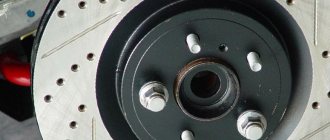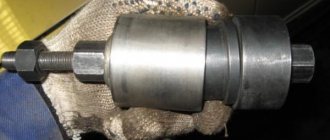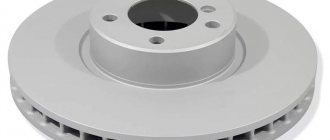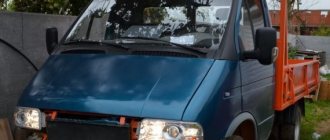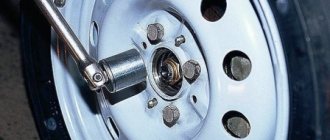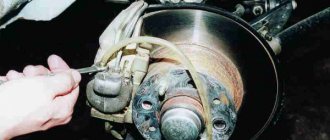Replacing brake pads on a VAZ 2110 with your own hands (video)
It is quite easy to determine a malfunction of the brake system by the first signs - a beating in the steering wheel and a metallic squeak coming from the front wheels. Such phenomena indicate that it is time to change the brake pads.
Brake kit
It is recommended to replace the rear brake pads on a VAZ 2110 simultaneously with changing the front ones. The fact is that the main part of the load during braking is taken on by the front elements. This is approximately 70 percent of the load. The rear ones serve more as a balance, so they wear out much less intensively than the front ones.
Let's take a closer look at how the rear and front pads are replaced on a VAZ 10.
Bleeding brakes on a VAZ 2110
Structurally, the brake system on the VAZ 2110 is unified; exactly the same configuration is used on other VAZ models. For beginners, it is better to use the method with an assistant who is more experienced in car repair and maintenance. The brakes are pumped strictly according to a certain pattern. First the back right side, then the left front, then the left back and finally the right side in front.
Method of pumping with the participation of an assistant
The procedure looks like this:
- Add fluid to the expansion tank to the maximum mark.
- If the vehicle is on a lift and the rear wheels are off, you should unlock the rear brake pressure regulator by inserting a flat-head screwdriver between the piston and the pressure plate.
- Clean all dirt from all outlet fittings on the wheel brake cylinders.
- Remove the protective rubber cap from the fitting for bleeding the system, put a rubber hose on it (suitable for a dropper) and lower the other end into a transparent bottle with brake fluid so that the end of the hose is in the liquid.
- At this time, the assistant should be in the driver’s seat and, at intervals of one or two seconds, press the brake pedal all the way, and then hold it pressed.
- When the brake pedal is pressed, you need to unscrew the fitting on the cylinder no more than one turn. Liquid with air bubbles will flow through the hose into the container. When the flow stops, you need to tighten the valve and repeat the procedure until clean liquid without air bubbles comes out into the container.
In this case, you need to constantly monitor the fluid level in the expansion tank and, if necessary, top up to the maximum mark.
After pumping one side, you can move to the other, so all circuits are pumped.
Bleeding the brakes without an assistant
To bleed the brakes alone without an assistant, you need to use a special device called an Aerator; it costs no more than 70 rubles, and if you wish, you can easily do it yourself. To do this you will need to purchase the following parts:
- cap of the expansion tank of the “classic” VAZ without a sensor;
- car wheel nipple;
- round file or needle file
A hole with a diameter of 14 mm is made in the lid, where the nipple is installed. After this, the valve on the tank is connected to the valve on the wheel. The car is jacked up and the wheels are removed. After this, you can unscrew the bleeder fitting half a turn, and the pressure from the nipple will quickly expel all the air from the system. One tire inflated to 2 atmospheres is quite enough. In this case, air can be supplied in other ways, for example, with a car compressor for inflating tires. It is not recommended to supply pressure above one atmosphere to the system, especially if a compressor is used, which can create excess pressure.
Every car enthusiast should know how the brake system is pumped, because safety on the road depends on serviceable and effective brakes, not only for the driver, but also for passengers, as well as other road users. This simple procedure does not take much time, but if it seems too complicated, you can always contact the service, where the procedure will be carried out even faster and will give a guarantee on the quality of the work performed.
Front
Before starting work on replacing the front brake pads on a VAZ 2110, be sure to arm yourself with a set of tools, which includes:
- Hammer with short handle;
- A small sharp chisel;
- Two wrenches - socket and socket 13;
- Open-end wrench 17;
- Pliers;
- Small crowbar;
- Jack;
- Balloon wrench;
- New pads.
When everything is ready to go, you can begin the replacement process.
- Park the car in such a way that it cannot roll away. It is best to put some kind of stoppers under the wheels. It is advisable to use special devices rather than simple bricks.
- Loosen the bolts on the front wheels and lift the car to one side using a jack.
- Completely remove the wheel mounting bolts, remove it and place it under a raised part of the machine. This is a simple safety measure in case the jack accidentally comes off.
- Now we determine the location of the front brake pads on the VAZ 2110. The calipers are located in front of the brake disc, so to easily replace the left pad, turn the steering wheel all the way to the left, and vice versa.
- To make it easier for you to access the part, arm yourself with a thin chisel and a hammer. These tools will unlock the top bolt.
- Unscrew it with a 13 socket wrench, holding it on the other side of the caliper with a 17 socket wrench.
- There is no need to remove the pad yet, since the caliper is now in its extreme position. That is, the new part will not fit into place.
- Do not completely unscrew the bolt; use a crowbar and insert it between the body and the pad, pressing the caliper all the way.
- Once this is done, unscrew the top bolt all the way. This will move part of the caliper to the side, thereby providing access to the pad itself.
- Remove the old pads and put new ones in their place.
- During assembly, simply follow the reverse order of dismantling. Just remember the importance of bolt countering. The washer must be bent onto the edge of the fastener. At this point the replacement can be considered complete.
Rear
For clarity, we recommend watching a video about replacing the rear brake pads on a VAZ 2110. This will make it easier to complete the task and have a visual representation of each stage of repairing the brake system.
It will be good if you once installed disc elements . The beauty of them is that the process of replacing the rear pads will be similar to the front ones.
The situation is completely different for those who use factory drum braking systems. The work will have to be done delicately, but completely achievable on your own.
To get started, arm yourself with a set of tools, which includes:
- Balloon wrench;
- Jack;
- Pliers;
- Screwdriver;
- Hammer;
- Sharp chisel;
- Open-end, socket and ring wrench sizes 12, 13 and 17 - 3 sizes of each type of wrench.
Now we proceed directly to replacing the rear brake pads.
- Place chocks under the front wheels and remove the rear wheel.
- Unscrew the guides using a 12mm wrench.
- Guides are required for fixing to the axle shafts of the drums.
- It may be quite difficult to remove the drum from its place. This is where you will need a hammer and a wooden stand. Tap the inside of the drum. It is strongly not recommended to hit the drum directly with a metal hammer, as the mechanism may be damaged.
- If the drum cannot be removed even after hammering, treat the contact areas with the hub with WD40 or other penetrating lubricants.
- Then, arm yourself with pliers and remove the springs from the bottom and top of the pads.
- Remove the guide spring located in front.
- This will allow you to completely remove the block.
- When the bar is removed, you can begin to remove the spring from the rear pad.
- Well, now remove both parts of the block. When removing the back one, remember the hook. It comes from the handbrake cable.
- After removing the old block, put a new one in its place. Assembly is carried out in reverse order.
- But there is one caveat - the bushing must be removed from the drive arm, which will greatly facilitate the reassembly process. The upper part of the pads is inserted into the grooves located on the cylinder rod.
- Be prepared for the fact that certain difficulties may arise when installing a new element. The reason is the large output that remains as a result of the operation of old brake elements.
- Take two pry bars and squeeze the two blocks together to bring them as close as possible. At this point the replacement can be considered completed.
- At the last stage, mandatory bleeding of the brake system is carried out. Without it, not a single intervention in the design of car brakes can be done.
Parsing order
It is better to carry out the repair operation on an overpass (you can use an inspection hole), or just a flat area with a hard surface, because you will have to remove the rear wheels, naturally, first jacking up the car.
So:
- Remove the wheel and disk;
- We unscrew the guide bolts, of which there are 2, and remove the drum;
- A common problem is the drum sticking, so sometimes it is not so easy to remove it. The problem has long been solved by tapping a drum with a hammer (through a board);
- Using pliers, remove the tension spring;
- After this, a fixing guide spring holding the block;
- We remove the block from the support bar that is not connected to the handbrake rod. To do this, pull its free edge to the side and along the shield;
- Loosen the upper spring. To do this, you need to turn the block to the side until you can disconnect the spring;
- We do the same with the spring of the second pad;
- Remove the spacer bar;
- Disconnect the handbrake rod from the cable;
- We note to ourselves or sketch how the connection to the rod is made;
- Unhook the spring, remove the cotter pin, and disconnect the brake pad.
Thus, the disassembly process is completed.
We change the front brake pads on a VAZ-2110 and make the right choice!
One of the most important consumables for a car is brake pads. And one of those that have to be changed quite often. Of course, not a single automaker will name a clear regulation for replacing pads. AvtoVAZ doesn’t call it either. Front brake pads on a VAZ-2110 last on average from 20 to 40–50 thousand, depending on the driver’s temperament and skills. Let's figure it out right now how to change and which ones are better to install front pads on the 10's.
Replacing the rear brake pads of a VAZ 2110. Step-by-step instructions
Minimum permissible thickness of friction linings for VAZ 2110 brake pads
-1.5 mm. Replace the pads in the following cases:
- the thickness of the friction linings is less than the permissible value;
-the surface of the linings is oily;
-friction lining
not firmly connected to the base;
- deep grooves and chips have formed on the linings.
You will need: a 12" wrench, a flat-blade screwdriver, a mounting spatula, a hammer, pliers or a bit for removing the tension springs.
1. Engage first gear and install thrust blocks under the front wheels.
2. Make sure that the parking brake lever is lowered all the way down (the car is released).
3.Remove the wheel and clean the brake mechanism from dirt.
4.If the brake fluid level in the master cylinder
is at the “MAX” mark or is approaching it, pump out some of the liquid from the reservoir. Otherwise, when replacing the pads, it may splash out.
5.Remove the brake drum.
6.Remove the upper tension spring with a punch or pliers.
7.Remove the lower tension spring in the same way.
8.Remove the front pad guide spring and then the front pad.
9.Remove the expansion bar.
10.Remove the rear shoe guide spring and then the rear shoe by disconnecting the drive arm from the parking brake cable end.
11.Remove the cotter pin and the support washer from the pin of the rear shoe
.
12.Press the pin and remove the drive lever from the block. Remove your finger from the block.
Briefly about the process of replacing brake pads on a VAZ-2110
On average, the pads need to be changed every 30 thousand mileage.
First, let's look at the simple technology of replacing pads on a ten. Anyone can change them, spending at most half an hour. For our work, we will need a standard set of tools, a pry bar or a powerful screwdriver, and a rag. WD-40 penetrating lubricant and guide block lubricant may also . And, of course, new pads. We change them only as a set on the right and left wheels.
Symptoms of wear
The middle pads will last about 30 thousand mileage and they wear out three times faster than the rear ones, since the main load during braking falls on them. Under no circumstances should you use pads from different sets or different degrees of wear; we install only a new set, from only one manufacturer.
Difference in thickness of old and new pads.
Regardless of the mileage, if these symptoms appear, we at least check the condition of the pads and discs:
- Creaks and clanks when braking.
- Vibration during braking.
- Increased braking distance.
- Large brake pedal travel.
- Uniform impacts when braking.
- Traces of dust and chips on the brake mechanisms.
It is these symptoms that will tell us that the service life of the brake pads has been exhausted. We can say with almost 100% confidence that the block has worn down to an acceptable thickness of 1.5–2 mm .
Let's start replacing.
Replacement algorithm
Since we are going to disassemble the brake caliper, we will evaluate the condition of the brake disc, boots, cuffs, hoses and cylinders .
- We place the car on a flat surface, place wheel chocks under the rear wheels and tighten the handbrake, remove the negative terminal from the battery.
- We remove the wheel bolts with a wheel wrench.
- Raise the car on a jack and remove the wheel.
Disconnect the pad wear sensor connector.
We bend the edge of the lock washer.
Unscrew the lower mounting bolt with a 13mm wrench.
Remove the bolt and lock washer.
We pry the caliper with a screwdriver to open it.
We remove the worn brake pads.
Before installing new pads, thoroughly clean the brake mechanism, lubricate the guide pin with high-temperature grease and reassemble in the reverse order.
After replacement, we check the operation of the brakes; the first few tens of kilometers the pads will wear in, so the braking efficiency will not be complete.
Video about replacing the front pads of a VAZ-2110
When it's time to replace
On VAZ 2112 vehicles, the front wheel pads must be replaced at least after 50 thousand kilometers. In each individual case, the timing is individual and depends on the driving style, technical condition of the caliper and driving mode. Therefore, it is likely that problems with braking may appear after 30 thousand kilometers.
Checking the pads of the VAZ 2110
It is worth understanding that a clear deterioration in braking performance is a sure signal to revise the brake system of the VAZ-2110 and the brake pads in particular. The maximum permissible thickness of the friction lining is 1.5 mm, but it’s really not worth bringing the product to this state. Uneven wear of the front pads indicates a problem with the caliper on Lada 2110, 2111 and 2112 models.
The degree of wear of the rear pads can be assessed by the depth of travel of the handbrake and the number of “clicks”. Ideally there should be no more than three or four. Wear of the rear pads leads to the fact that the stroke of the lever and, accordingly, the traction increases. If you neglect timely replacement, the car may begin to roll downhill even with the handbrake on.
Replacement of front pads VAZ 2112 (2110)
Replacement for cars of the VAZ-2110 family is not very complicated and can be performed in the following sequence:
- 1. Raise the front of the car with a jack, unscrew the wheel mounting bolts and remove it. To secure the jack, the wheel can be placed under the bottom of the car;
- 2. First loosen the safety washers holding the caliper bracket screws. Now you need to unscrew the upper screw and slightly loosen the lower one;
- 3. With some effort, knock the upper part of the bracket to the side. It can now be folded back using the bottom bolt as a lever;
- 4. Finally, you have access to the brake pads of your VAZ-2110 car and can freely replace them. You can easily remove the old pads, assessing the degree of their wear, and insert new ones in the same way.
When reassembling the caliper, do not forget to pull in the cylinder, which prevents the installation of the brake mechanism along with the new pads. It will be enough to use any available lever and forcefully press the cylinder inward. For these purposes, the wrench that you use to unscrew the car wheels, which is right at your fingertips, is quite suitable.
Choosing the right pads!
The standard brake pad for the front ten brakes has the following parameters:
- length 104.3 mm;
- height 62.1 mm;
- thickness 17.5 mm.
Dimensions of a standard VAZ-2110 disc pad.
When choosing pads, you should consider not so much their price as the material of the friction lining . And this material, in turn, depends on the driving style and preferences of the driver.
Selecting the material and category of pads
Briefly, each of the materials has the following characteristics:
- Semi-metallic clutches. The most inexpensive, they are made from a friction mixture, which includes graphite, inorganic fillers and 60–65% chips of non-ferrous and ferrous metals. Such pads dissipate heat well, do not overheat, but wear out the brake disc a lot. Noisy and very dusty. They do not work well in low temperatures.
- Low metal pads. Same story, but the percentage of metal content is reduced to 30–35% . Mainly composed of organic fillers. Softer and less noisy pads.
- Organic pads. Consist of glass material, carbon fiber, Kevlar. The metal content does not exceed 12–15% . The pads are very soft and low noise, but they wear out intensively. But organics are gentle on the brake disc and have good friction properties at the initial stage of braking. Not recommended for fans of an aggressive driving style, but a calm, balanced driver will comfortably drive them for at least 40–50 thousand.
- Ceramic friction linings. The best option for conditions where intensive and frequent braking and high speeds are required. The basis of the lining is ceramic fiber; rubber and soft non-ferrous metals are included in different proportions. Ceramic pads are equally effective at both low and high temperatures, do not wear out the brake disc much, and last quite a long time.
In addition to material, pads are distinguished by categories, roughly speaking, by quality of workmanship. There are three of them - a conveyor, an aftermarket and a spare parts market for third countries:
- original conveyor pads are supplied directly to the factory, they meet all possible standards, although judging by the original VAZ-2110 pads, this is not always the case;
- aftermarket is a complete copy of the original pads, they cost half as much, but the quality can sometimes be better than that of the original ones;
- Pads for third-party markets look no different from aftermarket spare parts, but the quality of the materials is an order of magnitude worse and they cost a third less.
But no matter what category the pad is, it must indicate basic parameters - operating temperature, coefficient of friction and catalog number.
We select brands and look at prices
The native tenth pads are not spoken of very flatteringly. They are only enough for a break-in, after which the braking efficiency drops noticeably and they begin to creak and vibrate. These are pads from the domestic TIIR plant with catalog number 2108 35010 80 . Their only advantage is that they are given free of charge (along with a new car), so you don’t mind throwing them away.
Standard TIIR pads.
Budget pads include Ferodo with number TAR527B at a price of about 400 rubles. Despite the price, they performed well both in tests and in real life. With godless use, they can withstand up to 40 thousand mileage, unless you run into a fake, of which there are quite a few. In the same price category there are Remsa , Dafmi , and there is inexpensive Nippon .
Budget brake pads FERODO TAR527B.
VAZ 2110 2111 2112 replacement of front brake pads. Video
We will show you how to quickly replace the front brake pads in VAZ 2110 2111 2112 cars with your own hands. We loosen the wheel bolts, raise the car on a jack or lift to the desired level. We remove the wheel and first of all inspect the condition of the brake discs. We turn the brake knuckle outward and clean the brake caliper using a brush with metal bristles to remove stubborn dirt.
We push the pads apart with a flat screwdriver or a pry bar:
Before removing the brake cylinder, it is necessary to unlock the lower bolt holding it:
Then unscrew this bolt with a wrench or a 13mm socket and remove it. Turn the cylinder on the upper guide clockwise and remove it, remove the brake hose from the bracket:
Now you can pull out the old brake pads and clean the sides in the places where the pads are located. You can use a screwdriver and a brush with metal bristles for this. We also clean the brake cylinder from the inside, then check the condition of its rubber boots.
If you have a professional tool for pressing the cylinder piston, use it; if not, you can do it like we did, using a clamp and an old block:
We take out the lower guide and check the condition of the rubber boot, remove the old grease using rags or paper towels. We do the same with the top guide. Old grease may remain in the caliper bracket; it is better to remove it from there. Using a brush, apply a special lubricant to our guides and put the rubber boots in place. Apply lubricant to the bracket where the brake pads move. For all our purposes, graphite lubricant is used. We put the front brake pads in place, put the brake cylinder in place and press the pads with it. We assemble everything in reverse order.
Video of replacing front brake pads in VAZ 2110 2111 2112:
Before you start driving, be sure to press the brake pedal several times to pump the fluid. Checking the brake fluid level.
Replacing the Brake Master Cylinder on a VAZ 2108
The brake master cylinder (MBC) is located under the hood of the car on the right side. The task of the GTZ is to evenly distribute the braking force by creating the same pressure of the brake fluid (BF) on all circuits.
Typically, the GTZ is removed to repair its mechanisms or completely replace it. Most often, pistons and cuffs fail, and to replace them it is necessary to remove and disassemble the master brake cylinder. As practice shows, usually the question of how to remove and disassemble the GTZ is a problem for most motorists.
In this article you will learn how to properly remove and disassemble the GTZ to save time, money and your own efforts. So, if you are ready, you can begin.
INSTRUCTIONS FOR REMOVAL OF VAZ 2108 GTZ WITH YOUR OWN HANDS
1. Unscrew the cap of the brake fluid reservoir together with the brake fluid reservoir, then remove the brake fluid reservoir, carefully pry it with something wooden and remove it from the seat.
2. Place a rag under the gas turbine engine to prevent the fuel fluid from getting on the electrical wiring and other components, then disconnect the pipes using a special key, which eliminates the possibility of “licking” the edges.
Attention! Be careful, the liquid is toxic and can stain clothing, plastic and rubber products. I recommend marking the tubes with paint or a marker so that nothing gets mixed up during assembly.. 3
The main brake cylinder of the VAZ 2108 is attached to the vacuum booster using two nuts.
3. The VAZ 2108 master brake cylinder is attached to the vacuum booster using two nuts.
4. Unscrew the fastening nuts and remove the cylinder from the studs.
We disassemble the Brake Master Cylinder with our own hands
Once the brake master cylinder is removed, disassembly can begin. Provided that you are not going to completely change the GTZ, but only want to change worn out elements (rubber seals, cuffs and brake pistons). Check the condition of the parts and, if necessary, replace faulty parts. The pistons are removed simply by hand or by supplying compressed air to the nozzle of the second chamber; the openings of the tank must be closed. Before assembly, make sure there are no burrs or scratches on the surfaces of the cylinders; if there are any, you will have to completely replace the VAZ 2108 GTZ.
If repairing the VAZ 2108 GTZ is impractical and you are going to completely change the master brake cylinder, then put the brake reservoir on it and put everything in place. Further details on how to install a new GTZ on a VAZ 2108.
Do we install the MAIN BRAKE CYLINDER ON A VAZ 2108 with our own hands?
1. Place the GTZ in place, then pour TJ into the tank.
2. Take the tubes and place them in such a way that they correspond to their place according to the markings you made during disassembly.
3. Use your fingers to close the holes for the pipes on the GTZ and ask someone to slowly press the brake pedal.
4. When you press the pedal, brake fluid will flow out of the first injectors of the master cylinder; it is at this moment that you need to tighten the brake pipes. The assistant does not release the brake pedal.
Now we can say that everything is ready. All that remains is to assemble everything and check the performance of the brakes.
Some important tips before replacing
VAZ 2110 front pads and their replacement
You need to use brake pads that are recommended by the manufacturer. If you plan to use the brake pads in the future, you should mark them when removing them. It is absolutely unacceptable to reinstall the pads from the inside to the outside and from the outside to the inside, as well as from the left wheel to the right.
Note. Brake pads on one axle must be replaced at the same time, even if only one of the pads is worn out.
The steering wheel should be turned towards the disassembled wheel until it stops to achieve maximum convenience when replacing brake pads.
Removing the front brake pads
VAZ 2110 front brake pads
Procedure for removing brake pads:
- First you need to mark with paint the location of the front wheels relative to the hubs.
Note. Thanks to this, during assembly, the balanced wheel can be installed in its original position.
- before starting to jack the car, the mounting bolts on the wheels should be loosened, the rear wheels of the car should be stopped with a stop;
- lift the front part of the car and place it on a stand;
- remove the front wheels.
Note. Please remember that lifting and placing the vehicle on a jackstand is hazardous.
- remove the rubber rings from the brake hose;
- we remove the wear sensor plug from the hole, but do not pull the cable while doing this;
- unhook the wire;
- remove the brake pad wear sensor from the holders;
Front pads for VAZ 2110 and wear sensor
- unscrew the mounting bolts at the top and bottom;
- it is necessary to remove the caliper from the guide block;
- Without disconnecting the brake hose, otherwise you will have to remove air from the brake system, attach the caliper with wire or electrical tape to the strut (see VAZ 2110: replacing the front struts on your own).
Note. In this case, be sure to check that the hose is not stretched.
- use a wooden block to prevent the piston of the brake cylinder from being squeezed out;
- We remove the front brake pads of the VAZ 2110 from the guide.
Note. When using removed brake pads, you should label them as follows: “outer” and “inner,” which will make it possible to install the pads in their original places.
Checking the brake pads
Front brake pads for VAZ 2110
- It is necessary to clean the place where the brake pads are installed on the guide and the place of the sliding surface with a light metal wire brush, and also moisten a rag in alcohol and wipe the brake discs (to do this, do not use tools with sharp edges or mineral solvent).
Note. It is recommended to use only alcohol to clean brakes.
Before installing the brake pads, check the brake disc with your fingers to see if there are any grooves or potholes. If there are grooves, then if the brake disc is thick enough, it can be machined. This procedure is performed at the service station:
- measure the thickness of the brake disc (it should not be less than 1.5 mm);
If the check shows that the pads are worn out, they need to be replaced. If necessary, the locking brackets are also replaced.
How to check pad wear
To independently check the degree of wear of the pads on a VAZ 2110 car, you should follow the process described below.
Front pads
- wheels are removed;
- the disk is cleaned of dust and dirt;
- a caliper is taken and the thickness is measured.
Note. Like pads, discs must have a certain level of wear. As a rule, the permissible wear of discs is 10.8 mm and no smaller. If the disc is too worn, it needs to be replaced.
- A visual inspection of the brake pads is carried out.
How to check pad wear
Note. You can determine the condition of the brake pads by looking through special holes designed for this purpose. As mentioned above, their thickness should not be less than 1.5 mm.
- The ease of movement of the pads is also checked.
Note. The ease of movement of the pads is checked with a screwdriver. If the pads are difficult to move, then it is likely that they are pinching the disc. You will have to replace the disc or caliper.
Rear pads
In order to check the brake pads at the rear, you should do the same, only after removing the wheels, you also need to remove the drum. Drum wear must also be measured. To do this you should:
- measure the diameter of the working surface of the drum.
Note. You should know that the maximum permissible wear should not exceed 201.5 mm in this case.
The following are situations when it is necessary to replace brake pads:
- if the thickness of the pads is less than one and a half millimeters;
- if the friction linings of the pads have traces of oil on the surface;
- if there is a poor connection of the linings with the base;
- if you hear a characteristic creaking noise when braking;
- if there is a beat when pressing the brake pedal.

